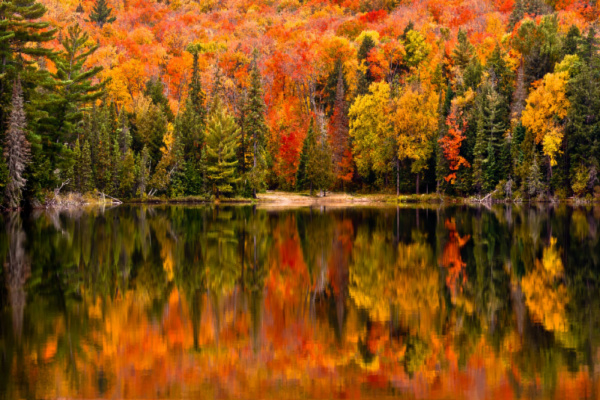The arrival of pumpkin spice lattes and cooler temperatures may mean fall is on its way, but nothing quite kicks off the season like when the leaves change into those vibrant hues of yellow, orange and red. The cascade of colors that erupts each September and October signal that change is on its way. So, what can leaf peepers expect this fall foliage season, and how might climate change impact when and how the leaves change color?
Where will leaves change colors first?
As CBS News reports, William Keeton, a professor of forestry at the University of Vermont, said leaves tend to peak earlier in the north, where temperatures cool off faster. Trees at higher elevations also tend to bust out their fiery colors sooner.
When will we start to see those familiar red, yellow, and orange hues?
Leaves generally begin their color metamorphosis in mid-September and reach peak vibrancy in early to mid-October. The timing hinges on a few different factors, explained Keeton, including geographic location, topography and local temperatures. Still, there’s no telling exactly when exactly the first domino will fall. “It’s always a little bit of a mystery every year exactly how all this is going to play out, which is why I refer to it as the great reveal,” said Keeton.
Why do leaves change color in the first place?
Chlorophyll is what gives leaves their green color. With the arrival of fall, temperatures drop and daylight dwindles, causing plants to stop producing the compound, said Mukund Rao, a postdoctoral research scientist at Lamont-Doherty Earth Observatory, which is part of the Columbia Climate School. What’s left are orange, brown, red, purple and yellow pigments, familiar perennial colors we see on oaks, maples, birches and other tree species.
Flavonoids and the carotenoids, which produce the yellow and the orange hues, are the same chemicals that give carrots and bananas their colors, explained Keeton. As the leaves get older, the pigments become brown and eventually the leaves fall off the trees, Rao said. That’s when it’s time to pull out the winter coat!
How does climate change affect the fall color change?
Experts say warmer conditions are prolonging the growing season, pushing the signs of fall’s arrival back later. Just one example of how temperatures make a difference: leaves may start to change in New York City almost a week later than the nearby Hudson Valley area due to the urban heat island effect, which makes the city warmer than its surroundings, said Rao.
Extreme weather induced by climate change can also put added stress on trees and compromise their ability to manufacture fall colors, Keeton said. Droughts, for example, disrupt the photosynthesis process, which produces the sugars that give the leaves their vibrancy. Without ample water, there’s less sugar in the trees, which leads to duller fall colors, said Rao. “Generally, summers with a lot of heat waves and drought conditions, you tend to have earlier falls and less flattering falls,” he said.
The National Oceanic and Atmospheric Administration, in its 2024 autumn precipitation and temperature forecast, said it predicts a “MUCH warmer-than-average outlook for temperatures for everyone except the Northern Tier.” NOAA says the Northeast and Northwest are expected to experience above-average precipitation over the next three months, while the rest of the country will see below-average levels.
Too much rain — another reality in the era of climate change — can throw fall foliage off kilter. Moisture created by the rain water can cause fungus to spread, which undermines the health of the leaves, said Keeton. As the Northeast gets rainier, the forestry professor predicts we’ll likely see more of these leaf diseases. While climate change is already altering the fall foliage season as we know it, the phenomenon will persist. “Fall colors are here to stay,” said Rao.
How does fall foliage impact the economy?
Fall colors aren’t just pleasing to the eyes, they’re also a huge moneymaker for local economies. Vermont’s Agency of Commerce and Community Development estimates that leaf peeping generates around $600 million and constitutes upwards of 20% of the state’s total annual tourism economic activity each year. “Certainly the fall foliage brings in a lot of visitors, and then they are all the businesses that are related to that,” he said. “It has a sizable impact up here.”
—
Photo Credit: James William Smith / Shutterstock.com
